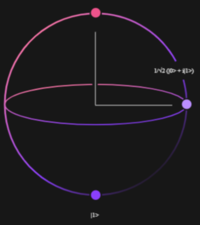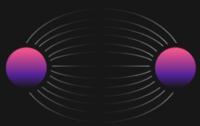Difference between revisions of "Quantum Computing"
| Line 1: | Line 1: | ||
Quantum computing is a theoretical computing model that uses a very different form of data handling to perform calculations. The emergence of quantum computing is based on a new kind of data unit that could be called non-binary, as it has more than two possible values. A traditional computer works on bits of data that are binary, or Boolean, with only two possible values: 0 or 1. In contrast, a quantum bit, or "qubit," has possible values of 1, 0 or a superposition of 1 and 0, in the case of an unknown value. According to scientists, qubits are based on physical atoms and molecular structures. However, many find it helpful to theorize a qubit as a binary data unit with superposition.<ref>Definition: What is Quantum Computing? [https://www.techopedia.com/definition/679/quantum-computing Techopedia]</ref> | Quantum computing is a theoretical computing model that uses a very different form of data handling to perform calculations. The emergence of quantum computing is based on a new kind of data unit that could be called non-binary, as it has more than two possible values. A traditional computer works on bits of data that are binary, or Boolean, with only two possible values: 0 or 1. In contrast, a quantum bit, or "qubit," has possible values of 1, 0 or a superposition of 1 and 0, in the case of an unknown value. According to scientists, qubits are based on physical atoms and molecular structures. However, many find it helpful to theorize a qubit as a binary data unit with superposition.<ref>Definition: What is Quantum Computing? [https://www.techopedia.com/definition/679/quantum-computing Techopedia]</ref> | ||
| + | |||
| + | == Quantum Computing Fundamentals<ref>Quantum Computing Fundamentals [https://www.research.ibm.com/ibm-q/learn/what-is-quantum-computing/ IBM]</ref> == | ||
| + | All computing systems rely on a fundamental ability to store and manipulate information. Current computers manipulate individual bits, which store information as binary 0 and 1 states. Quantum computers leverage quantum mechanical phenomena to manipulate information. To do this, they rely on quantum bits, or qubits. | ||
| + | |||
| + | Three quantum mechanical properties — superposition, entanglement, and interference — are used in quantum computing to manipulate the state of a qubit. | ||
| + | |||
| + | '''Superposition''' | ||
| + | Superposition refers to a combination of states we would ordinarily describe independently. To make a classical analogy, if you play two musical notes at once, what you will hear is a superposition of the two notes. | ||
| + | |||
| + | [[File:Quantum_Computing_-_Supposition.png |200px|Quantum Computing - Supposition]] | ||
| + | |||
| + | '''Entanglement''' | ||
| + | Entanglement is a famously counter-intuitive quantum phenomenon describing behavior we never see in the classical world. Entangled particles behave together as a system in ways that cannot be explained using classical logic. | ||
| + | |||
| + | |||
| + | [[File:Quantum_Computing_-_Entanglement.png |200px|Quantum Computing - Entanglement]] | ||
| + | |||
| + | |||
| + | '''Interference''' | ||
| + | Finally, quantum states can undergo interference due to a phenomenon known as phase. Quantum interference can be understood similarly to wave interference; when two waves are in phase, their amplitudes add, and when they are out of phase, their amplitudes cancel. | ||
| + | |||
| + | [[File:Quantum_Computing_-_Interference.png |300px|Quantum Computing - Interference]] | ||
| Line 23: | Line 45: | ||
== Further Reading == | == Further Reading == | ||
*Quantum Computing: A Gntle Introduction [https://c-4tvylwolbz9x24ttyjx2ehtzzx2ejhzx2eju.g00.extremetech.com/g00/3_c-4ddd.leayltlaljo.jvt_/c-4TVYLWOLBZ9x24oaawx3ax2fx2fttyj.htzz.jhz.jux2fasix2f978479x2fD797847991375827911885.wkm_$/$/$/$?i10c.ua=1&i10c.dv=20 Eleanor Rieffel and Wolfgang Polak] | *Quantum Computing: A Gntle Introduction [https://c-4tvylwolbz9x24ttyjx2ehtzzx2ejhzx2eju.g00.extremetech.com/g00/3_c-4ddd.leayltlaljo.jvt_/c-4TVYLWOLBZ9x24oaawx3ax2fx2fttyj.htzz.jhz.jux2fasix2f978479x2fD797847991375827911885.wkm_$/$/$/$?i10c.ua=1&i10c.dv=20 Eleanor Rieffel and Wolfgang Polak] | ||
| + | *When Will Quantum Computers Outperform Regular Computers? [https://gizmodo.com/when-will-quantum-computers-outperform-regular-computer-1834651018 Gizmodo] | ||
* | * | ||
Revision as of 17:50, 12 July 2019
Quantum computing is a theoretical computing model that uses a very different form of data handling to perform calculations. The emergence of quantum computing is based on a new kind of data unit that could be called non-binary, as it has more than two possible values. A traditional computer works on bits of data that are binary, or Boolean, with only two possible values: 0 or 1. In contrast, a quantum bit, or "qubit," has possible values of 1, 0 or a superposition of 1 and 0, in the case of an unknown value. According to scientists, qubits are based on physical atoms and molecular structures. However, many find it helpful to theorize a qubit as a binary data unit with superposition.[1]
Quantum Computing Fundamentals[2]
All computing systems rely on a fundamental ability to store and manipulate information. Current computers manipulate individual bits, which store information as binary 0 and 1 states. Quantum computers leverage quantum mechanical phenomena to manipulate information. To do this, they rely on quantum bits, or qubits.
Three quantum mechanical properties — superposition, entanglement, and interference — are used in quantum computing to manipulate the state of a qubit.
Superposition Superposition refers to a combination of states we would ordinarily describe independently. To make a classical analogy, if you play two musical notes at once, what you will hear is a superposition of the two notes.
Entanglement Entanglement is a famously counter-intuitive quantum phenomenon describing behavior we never see in the classical world. Entangled particles behave together as a system in ways that cannot be explained using classical logic.
Interference
Finally, quantum states can undergo interference due to a phenomenon known as phase. Quantum interference can be understood similarly to wave interference; when two waves are in phase, their amplitudes add, and when they are out of phase, their amplitudes cancel.
Quantum Computing Models[3]
There are a number of quantum computing models, distinguished by the basic elements in which the computation is decomposed. The four main models of practical importance are:
- Quantum gate array (computation decomposed into a sequence of few-qubit quantum gates)
- One-way quantum computer (computation decomposed into a sequence of one-qubit measurements applied to a highly entangled initial state or cluster state)
- Adiabatic quantum computer, based on quantum annealing (computation decomposed into a slow continuous transformation of an initial Hamiltonian into a final Hamiltonian, whose ground states contain the solution)
- Topological quantum computer(computation decomposed into the braiding of anyons in a 2D lattice)
The quantum Turing machine is theoretically important but the direct implementation of this model is not pursued. All four models of computation have been shown to be equivalent; each can simulate the other with no more than polynomial overhead.
See Also
References
Further Reading
- Quantum Computing: A Gntle Introduction Eleanor Rieffel and Wolfgang Polak
- When Will Quantum Computers Outperform Regular Computers? Gizmodo



